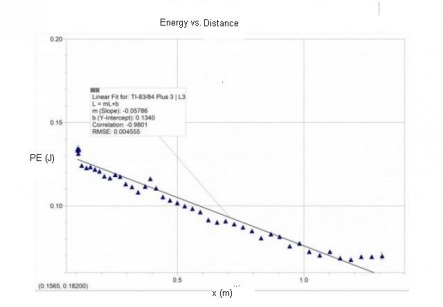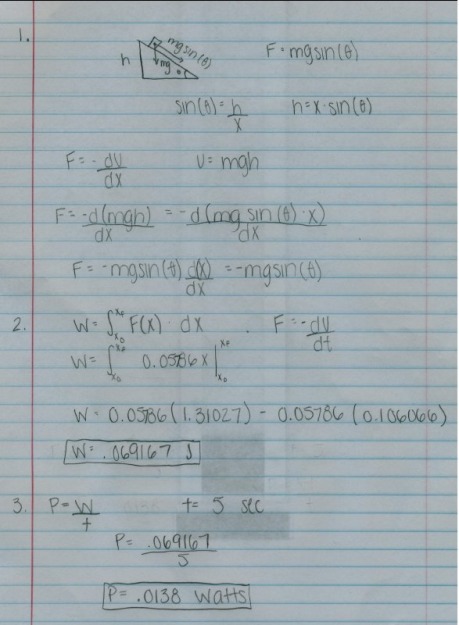Tamara- AP Physics
Potential Energy Lab
Purpose:
· To analyze a body in motion in a conservative force field and develop a mathematical model describing the relationship between potential energy of the body and the distance travelled.
· Apply the mathematical model to calculate the force acting on the body throughout its journey.
· Analyze the work done and power generated by the body.
Materials:
· Pasco track and cart with two 250-gram masses
· Motion detector and CBL system
· Triple beam balance
· Metric ruler
· Level
· Ring stand and mounting clamp for the motion detector
· Pasco track and cart with two 250-gram masses
· Motion detector and CBL system
· Triple beam balance
· Metric ruler
· Level
· Ring stand and mounting clamp for the motion detector
Data
x (m)
0.106066
0.110508
0.108009
0.105788
0.106066
0.10551
0.105233
0.10551
0.104955
0.108009
0.121614
0.140218
0.156044
0.173814
0.191862
0.211298
0.233233
0.254057
0.273494
0.295706
0.320418
0.344574
0.372618
0.393164
0.415932
0.442865
0.470909
0.499785
0.529217
0.559759
0.59058
0.622788
0.657495
0.690814
0.724966
0.759674
0.795214
0.831587
0.870182
0.904889
0.944594
0.983189
1.02178
1.06371
1.10369
1.14423
1.18671
1.22781
1.26918
1.31027
0.106066
0.110508
0.108009
0.105788
0.106066
0.10551
0.105233
0.10551
0.104955
0.108009
0.121614
0.140218
0.156044
0.173814
0.191862
0.211298
0.233233
0.254057
0.273494
0.295706
0.320418
0.344574
0.372618
0.393164
0.415932
0.442865
0.470909
0.499785
0.529217
0.559759
0.59058
0.622788
0.657495
0.690814
0.724966
0.759674
0.795214
0.831587
0.870182
0.904889
0.944594
0.983189
1.02178
1.06371
1.10369
1.14423
1.18671
1.22781
1.26918
1.31027
U (PE) (J)
0.13315231743
0.133864807107
0.133689424719
0.133864807107
0.133899883235
0.13389403721
0.133900614
0.133899883235
0.133841422986
0.13126989177
0.124067538556
0.12266452881
0.123201649995
0.121740049565
0.120582493885
0.117677011194
0.116569987044
0.118536509943
0.117458560585
0.113029538778
0.111264772484
0.108072734765
0.111521213817
0.116117013839
0.110486494656
0.105251996805
0.103190540786
0.101674321952
0.0998064539005
0.0982096256362
0.0962452898732
0.0914576386004
0.0900368348896
0.0907501606471
0.0889562732411
0.087125586508
0.0848806340575
0.0806284177845
0.0829698316292
0.0814148295113
0.0757877372865
0.077424878162
0.0724441977736
0.0703065708131
0.0724438924786
0.0685703467784
0.0676933077757
0.0694412253128
0.0694412253128
0.0698744732325
0.13315231743
0.133864807107
0.133689424719
0.133864807107
0.133899883235
0.13389403721
0.133900614
0.133899883235
0.133841422986
0.13126989177
0.124067538556
0.12266452881
0.123201649995
0.121740049565
0.120582493885
0.117677011194
0.116569987044
0.118536509943
0.117458560585
0.113029538778
0.111264772484
0.108072734765
0.111521213817
0.116117013839
0.110486494656
0.105251996805
0.103190540786
0.101674321952
0.0998064539005
0.0982096256362
0.0962452898732
0.0914576386004
0.0900368348896
0.0907501606471
0.0889562732411
0.087125586508
0.0848806340575
0.0806284177845
0.0829698316292
0.0814148295113
0.0757877372865
0.077424878162
0.0724441977736
0.0703065708131
0.0724438924786
0.0685703467784
0.0676933077757
0.0694412253128
0.0694412253128
0.0698744732325
Data Analysis
1. Using the relationship between potential energy, distance and force, determine the force acting on the cart during its journey down the track.
Force is -du/dx which is the slope. The slope is 0.05786.
2.. Choose three different heights along the track and compare the potential energy determined by the mathematical model at the horizontal distance with the potential energy calculated using U = mgh. Report the percent difference between these values. What is the cause of difference between the values?
Question not needed.
1. Using the relationship between potential energy, distance and force, determine the force acting on the cart during its journey down the track.
Force is -du/dx which is the slope. The slope is 0.05786.
2.. Choose three different heights along the track and compare the potential energy determined by the mathematical model at the horizontal distance with the potential energy calculated using U = mgh. Report the percent difference between these values. What is the cause of difference between the values?
Question not needed.
Extension
1. Using the basic principles of F = -dU/dx and U = mgh, (and ignoring friction) prove that the force experienced by the cart moving down the track is equal to the x-component of the cart’s weight vector.
(below)
2. Determine the work done by gravity from x0 to xf.
(below)
3. Determine the power generated when work is done from x0 to xf.
(below)
1. Using the basic principles of F = -dU/dx and U = mgh, (and ignoring friction) prove that the force experienced by the cart moving down the track is equal to the x-component of the cart’s weight vector.
(below)
2. Determine the work done by gravity from x0 to xf.
(below)
3. Determine the power generated when work is done from x0 to xf.
(below)
Conclusion
This lab allowed us to analyze a body in motion. It helped students learn about work and power. The power is .0138 watts and the work is .069167 joules. It showed how potential energy at the top of the ramp converts to kinetic energy at the bottom (even though we stopped the cart). The mathematical equation is y=-0.05786x+0.1340. To calculate the distance, we used a motion detector. The main problem with this lab was the interpretation of data by the different groups. The data showed bad measurements. We had to observe the data to make sure that the calculations seemed accurate, unlike 4000 joules. This lab was beneficial in learning the concepts of potential energy, power, and work.
This lab allowed us to analyze a body in motion. It helped students learn about work and power. The power is .0138 watts and the work is .069167 joules. It showed how potential energy at the top of the ramp converts to kinetic energy at the bottom (even though we stopped the cart). The mathematical equation is y=-0.05786x+0.1340. To calculate the distance, we used a motion detector. The main problem with this lab was the interpretation of data by the different groups. The data showed bad measurements. We had to observe the data to make sure that the calculations seemed accurate, unlike 4000 joules. This lab was beneficial in learning the concepts of potential energy, power, and work.


